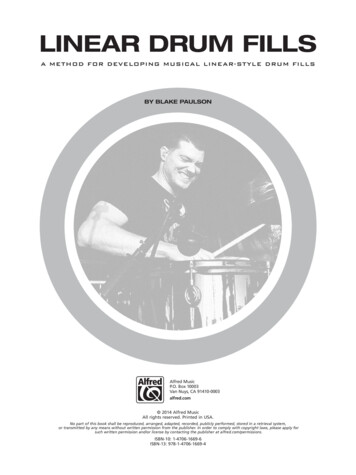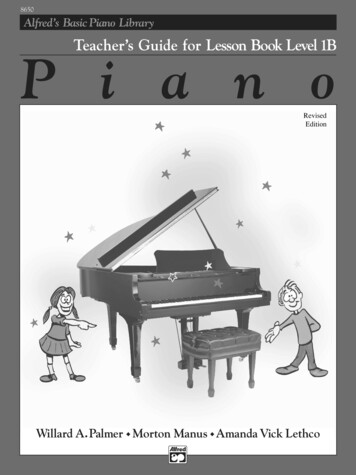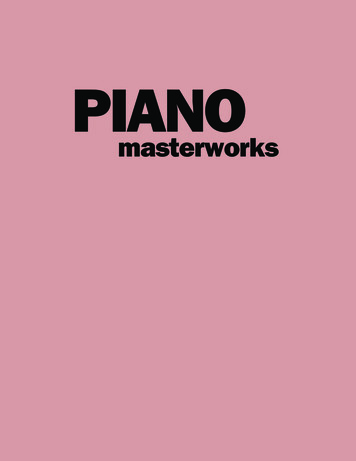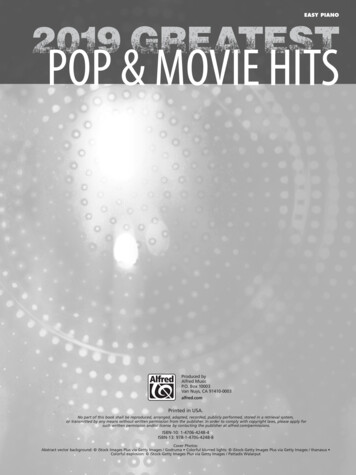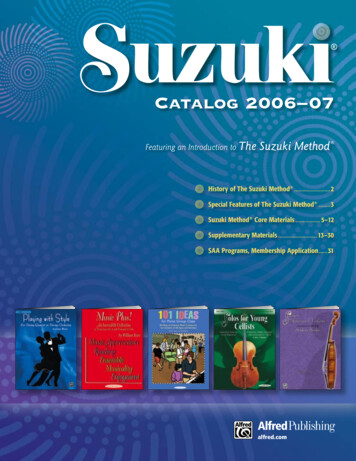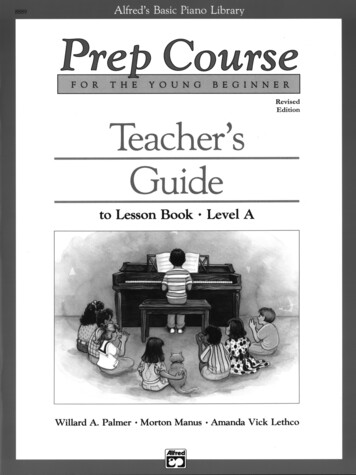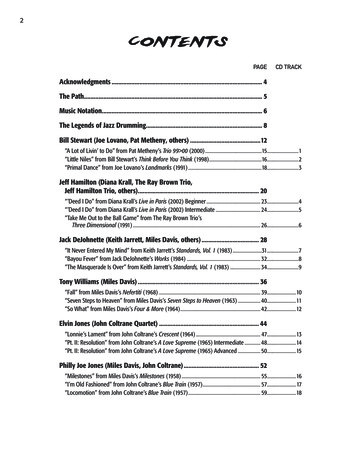
Transcription
2ContentsPageCD TrackAcknowledgments. 4The Path. 5Music Notation. 6The Legends of Jazz Drumming. 8Bill Stewart (Joe Lovano, Pat Metheny, others).12“A Lot of Livin’ to Do” from Pat Metheny’s Trio 99 00 (2000).15.1“Little Niles” from Bill Stewart’s Think Before You Think (1998).16.2“Primal Dance” from Joe Lovano’s Landmarks (1991).18.3Jeff Hamilton (Diana Krall, The Ray Brown Trio,.Jeff Hamilton Trio, others). 20“’Deed I Do” from Diana Krall’s Live in Paris (2002) Beginner. 23.4“’Deed I Do” from Diana Krall’s Live in Paris (2002) Intermediate. 24.5“Take Me Out to the Ball Game” from The Ray Brown Trio’sThree Dimensional (1991). 26.6Jack DeJohnette (Keith Jarrett, Miles Davis, others). 28“It Never Entered My Mind” from Keith Jarrett’s Standards, Vol. 1 (1983).31.7“Bayou Fever” from Jack DeJohnette’s Works (1984). 32.8“The Masquerade Is Over” from Keith Jarrett’s Standards, Vol. 1 (1983). 34.9Tony Williams (Miles Davis). 36“Fall” from Miles Davis’s Nefertiti (1968). 39.10“Seven Steps to Heaven” from Miles Davis’s Seven Steps to Heaven (1963). 40.11“So What” from Miles Davis’s Four & More (1964). 42.12Elvin Jones (John Coltrane Quartet). 44“Lonnie’s Lament” from John Coltrane’s Crescent (1964). 47.13“Pt. II: Resolution” from John Coltrane’s A Love Supreme (1965) Intermediate. 48.14“Pt. II: Resolution” from John Coltrane’s A Love Supreme (1965) Advanced. 50.15Philly Joe Jones (Miles Davis, John Coltrane). 52“Milestones” from Miles Davis’s Milestones (1958). 55.16“I’m Old Fashioned” from John Coltrane’s Blue Train (1957). 57. 17“Locomotion” from John Coltrane’s Blue Train (1957). 59.18
3PageCD TrackMax Roach (Dizzy Gillespie, Charlie Parker, Miles Davis, others). 62“The Drum Also Waltzes” from Max Roach’s Drums Unlimited (1966). 65.19“Blues Waltz” from Max Roach’s Jazz in 3/4 Time (1957). 66.20“Ko-Ko” from Charlie Parker’s Re-Boppers’ The Complete Savoy andDial Master Takes (1945). 68.21Art Blakey (Art Blakey & The Jazz Messengers). 70“Moanin’” from Art Blakey & The Jazz Messengers’ Moanin’ (1958) Beginner. 73.22“Moanin’” from Art Blakey & The Jazz Messengers’ Moanin’ (1958) Intermediate. 75.23-25“In Walked Bud” from Thelonious Monk’s The Very Best(2005, song originally recorded in 1947). 76.26Buddy Rich (Buddy Rich Big Band, Tommy Dorsey,Harry James, others). 78“Channel One Suite” from The Buddy Rich Big Band’sMercy, Mercy (1968) Beginner. 82.27“Jumpin’ at the Woodside” from Gene Krupa & Buddy Rich: Compact Jazz (1955). 83.28“Channel One Suite” from The Buddy Rich Big Band’sMercy, Mercy (1968) Advanced. 84.29-30Joe Morello (The Dave Brubeck Quartet). 86“Blue Rondo à la Turk” from The Dave Brubeck Quartet’s Time Out (1959). 89.31“Take Five” from The Dave Brubeck Quartet’s Time Out (1959) Intermediate. 90.32“Take Five” from The Dave Brubeck Quartet’s Time Out (1959) Advanced. 92.33Gene Krupa (Benny Goodman Orchestra). 94“Sing, Sing, Sing” from Benny Goodman and his Orchestra’s Sing, Sing, Sing (1937).97.34“King Porter Stomp” from Gene Krupa & Buddy Rich: Compact Jazz (1955). 98.35“Bernie’s Tune” from Gene Krupa & Buddy Rich: Compact Jazz (1955). 100.36“Papa” Jo Jones (Count Basie Band).102“One O’Clock Jump” from Count Basie Band’sThe Complete Decca Recordings (1937). 105.37“Little Susie” from The Essential Jo Jones (1958). 106.38“Cubano Chant” from The Essential Jo Jones (1958). 107.39Jazzography .110Audio examples performed by John O’Reilly Jr.Tracks 19-28, 34, and 35 performed by Rich Lackowski.
62Max Roach(Dizzy Gillespie, Charlie Parker, Miles Davis, others)Max Roach is one of the most innovative and enlightened artists of the 20th century. Bestknown for breathing life into the intellectual and improvisational style of bop at a timewhen swing was growing tired and exhausted, Roach completely liberated the drummer fromthe confines of structured rhythm, and single-handedly transformed the drums into a melodicsolo instrument.Max Roach was born January 8, 1924, in New Land, North Carolina. He moved to Brooklyn, NewYork, when he was age four, he learned to play the drums by age 10, and he played a performancewith Duke Ellington by age 16. Roach was largely influenced by Baby Dodds (Louis Armstrong andHis Hot Seven, King Oliver’s Creole Jazz Band, Jelly Roll Morton’s Red Hot Peppers) and the firstdrummer to play bop, Kenny Clarke (Dizzy Gillespie, Thelonious Monk).Roach’s style is less obsessed with the precise rudimental chops that dominated the swing era,particularly the style played by Buddy Rich and Gene Krupa, and instead focuses on the melodiccapabilities of the instrument. Roach somehow transforms the drum kit into a full music combo,effortlessly switching back and forth between rhythms and melodies. This can be heard withvivid clarity on the tune “Blues Waltz” from the album Jazz in 3/4 Time. Notice how Max plays thedrums as a rhythmic instrument, keeping time under the solos of his colleagues until his ownsolo at approximately five minutes into the track, at which point his hands transform the cymbals,toms, and snare into a cohesive melodic solo instrument while his feet continue to hold downthe rhythmic responsibilities on the kick and hi-hat. Another unique aspect of Max’s playing is hisfree-form style, which he contrasts beautifully with temperamental and explosive outbursts. Onelast signature of Roach’s playing is his ability to unleash at any given moment into his blisteringfast ride playing.Max is definitely a fearless leader who transcends time and space, guiding us into unexploredterritory, sometimes dissonant and333fearful,444 777 999 and sometimes upbeat and joyful. His sticks were like888 completely free-form, whatever suited his mood. Hispaintbrushes and his canvas was 444, 444 , 444 ormark has been made on timeless recordings with Charlie Parker, Dizzy Gillespie, Thelonious Monk,Coleman Hawkins, Bud Powell, and Miles Davis, and he will always be remembered as an artistwho walked through walls when it came to expanding the boundaries of self-expression.“Much later in my career I got to know and toplay alongside Max, a fantastic experience. Maxwas a wonderful man who gave me faith in myown ability. Just a great player and a gentlemanwhom I will always remember with affection.”—Ginger Baker
68”Ko-Ko”from Charlie Parker’s Re-Boppers’The Complete Savoy and Dial Master Takes (1945)Level: AdvancedAfter some beautiful brush work on the snare, Roach picks up some sticks and helps redefine jazzby putting the emphasis on a lightning-fast ride pattern backed up with some tasty snare and kickaccents. This style of playing became the standard for bop drumming and is incredibly difficult toplay, mainly because of the sheer speed. The following transcription is from 16 bars of the tune thatfaithfully represent the kinds of kick and snare patterns Roach interlaces throughout the tune.Chap 8.mus4 Example 8.20Original Transcription(1:03–1:16):Track 21q 284¿œ¿¿¿ ¿ ¿ ¿ ¿ ¿¿ ¿ ¿ œ œ4œÓã4 Œ ¿ œ ¿ Œ ¿ Œ ¿Ride Cym. cont. H.H. cont.㜠Œ Ó㜠Œ Œ œExample 8.14j‰œŒÓÓœ Œ Ó œ ŒChap 8.musÓœ Œ œ œ Ó Óœ ŒRide Cym. cont.¿¿¿¿¿¿¿¿¿¿¿¿4 œ Œ Óã 4 Œœ œ ¿ œ ¿ Œ ¿ Œ ¿ œ œ Óœ Œ H.H.Ó cont.œ Œ Œ œ Ó œãœ œ Ó㜠Œ Œ œ Óœ Œ jÓ ‰œ Œ œ Œ Óœ Œ Óœ Œ Œ œ ÓStart by playing a basic jazz swing beat on the ride, the hi-hat on beats 2 and 4 with the foot, andthe kick on beat 1 of every other bar. Start slowly, and gradually increase the tempo until you canplay it quickly and steadily. When you start to get to faster tempos, the swung ride beat should startto straighten out, with the eighth notes being bounced on the ride. If you feel yourself tensing up atquick tempos,Example8.15slow down and relax your grip. You’ll notice that the fastest jazz drummers play witha very relaxed temperament.ã 44. ¿ ¿ ¿ ¿ ¿ ¿ ¿ ¿ ¿ ¿ ¿ ¿ .œ ¿ Œ ¿ Œ ¿ Œ ¿Example 8.164ã4¿ ¿¿¿ ¿¿ ¿ ¿¿ ¿ ¿¿œœ. œ.Œ ¿ Œ ¿ Œ ¿ Œ ¿ .œ
96Drum BoogieGene Krupa is respectfully referred to as the “father of the modern drumset” for the finecontributions he has made to the instrument. Shortly after he earned an endorsement withSlingerland drums in 1935, Krupa convinced the company to make tunable tom toms in 1936, amove that would forever replace the old tacked-head Chinese tom that drummers used to clip ontothe rim of their kick drums. He also helped develop the legendary Radio King snare drum. GeneKrupa was such an influential and important endorser to Slingerland that he was featured on everyone of their drum catalogs from 1936 to 1967.Circa 1940s32CA4aa15BSlingerland Radio King,White Marine Pearl FinishA: 14” x 26” kickB: 6.5” x 14” Gene Krupa Artist Radio King snareC: 9” x 13” rack tomD: 16” x 16” floor tomE: 16” x 16” or 16” x 18” floor tomZildjian1: 12” hi-hats2: 13” medium thin crash3: 8” splash4: 14” ride5: 16” medium thin crashPercussionaa: cowbellDE
The following transcription is from 16 bars of the tune that faithfully represent the kinds of kick and snare patterns Roach interlaces throughout the tune. Original Transcription (1:03–1:16):


